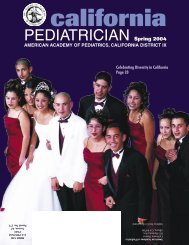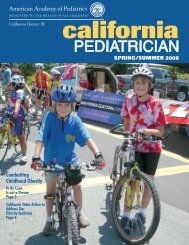PEDIATRICIAN Spring 2003 - AAP-CA
PEDIATRICIAN Spring 2003 - AAP-CA
PEDIATRICIAN Spring 2003 - AAP-CA
You also want an ePaper? Increase the reach of your titles
YUMPU automatically turns print PDFs into web optimized ePapers that Google loves.
Retirement should not be dull or<br />
boring. With the increase in the average<br />
life expectancy, more and more<br />
of us can look forward to years of active life<br />
after retirement. If it is not necessary to make<br />
money, the number of choices available is<br />
truly astonishing. Fortunately this is true even<br />
for those with physical limitations. Retired<br />
pediatricians can choose to stay in touch with<br />
their profession. Alternately, this is a time to<br />
pursue some favorite activity which was limited<br />
by time available before retirement. It is<br />
even possible to go back to school and become<br />
educated in an entirely new area. A partial list<br />
of possibilities organized by category follows.<br />
Pediatric Related:<br />
Retirement Options for<br />
Pediatricians<br />
If a retired pediatrician is located in an area<br />
with access to a medical school or training<br />
program, there are opportunities for teaching.<br />
Many programs use practicing or retired pediatricians<br />
as voluntary faculty. This involves<br />
making rounds on wards or supervising students<br />
and residents in clinics for assigned periods.<br />
Selection of a clinic in a particular area in<br />
which the physician can indulge a long standing<br />
interest can be very rewarding. Malpractice<br />
insurance for the faculty is covered by the<br />
medical school or hospital in most instances.<br />
Contact can be made with the Chairman of the<br />
Pediatric Department or the Chief of the Resident<br />
Training Program.<br />
Most medical schools have a mentor program<br />
for students usually starting in the first<br />
or second year. Students are assigned to physicians<br />
in areas of specialty which they choose.<br />
Practicing physicians are particularly desirable<br />
as having different experiences from faculty.<br />
Mentoring can take minimal or more time<br />
depending on the number of students and the<br />
interpersonal chemistry involved. Information<br />
can be obtained from the Student Affairs Office<br />
of the medical school.<br />
Many communities have free clinics for<br />
families without health care coverage. These<br />
can be sponsored by religious organizations,<br />
schools or community organizations. It is possible<br />
to cover a specific time for a specified<br />
period. Malpractice insurance can be a problem<br />
for retired physicians and this should be<br />
investigated before making a commitment.<br />
Joan E. Hodgman, M.D.<br />
American Academy of Pediatrics:<br />
Each Academy Chapter has a number of<br />
committees chaired and manned by volunteer<br />
members. The number and level of activity<br />
depend largely on the interests of the chapter<br />
members. Areas that are particularly active<br />
include legislation, access to care, reimbursement,<br />
membership, violence and accident prevention,<br />
school health and international health.<br />
Participation is actively encouraged and well<br />
received. It is possible for a member with a<br />
special interest to develop a task force to work<br />
on that issue. Each chapter has staff available<br />
to assist with meeting notices, agendas and<br />
minutes. California District IX has an active<br />
State Government Affairs committee with representatives<br />
from each chapter who have been<br />
appointed because of their interest.<br />
Educational:<br />
Schools are encouraging older individuals to<br />
become students again. After retirement is an<br />
optimal time to return to school and study a<br />
subject just for pleasure. Local community colleges<br />
have little or no tuition and a full curriculum<br />
of courses, including cultural subjects such<br />
as music appreciation and art history, courses<br />
in foreign languages, drawing and sculpture are<br />
available, as well as computers. Taking a shop<br />
course is a great opportunity for a woman of<br />
a certain age to learn how to take care of the<br />
upkeep of her house, something she was not<br />
taught in her youth.<br />
Hobbies:<br />
Retirement is a time to seriously indulge a<br />
hobby. Gardening, Bridge, physical activities<br />
such as tennis, swimming and running are all<br />
available at community centers. There are<br />
competitions organized by age group for many<br />
of the activities particularly swimming, tennis<br />
and rowing. Access can be through a community<br />
senior center. Many communities have<br />
amateur performance groups where an individual<br />
can indulge a taste for singing, dancing<br />
or acting. This is also a time to polish skills in<br />
playing a musical instrument or learn to play a<br />
new one. And, one is never too old for golf.<br />
Community Service:<br />
The potential here is mind-boggling. All museums<br />
have docents who are regularly educated<br />
in the specialties of the museum and then<br />
volunteer to conduct tours for members and<br />
guests, including children’s groups. Big Brothers<br />
and Big Sisters are represented in many<br />
communities. Retired pediatricians make<br />
particularly knowledgeable candidates to support<br />
a disadvantaged child. Communities have<br />
appointed committees to advise the officials in<br />
specific areas such as cultural affairs, population<br />
growth, property density among others.<br />
Interest in community affairs could lead to<br />
entering politics as a member of the school<br />
board or city council.<br />
The above suggestions are only the tip of<br />
the iceberg. California Pediatrician would like<br />
to hear from readers with their own experiences<br />
to share. These should be sent to the<br />
author by e-mail, FAX or snail mail.<br />
Joan E. Hodgman, M.D.<br />
494 Stanford Drive, Arcadia, <strong>CA</strong> 91007<br />
(323) 226-3440 FAX<br />
hodgman@hsc.usc.edu<br />
SED CONTINUED FROM PAGE 29<br />
the SED referrals and billing processes and<br />
HFP updates. A copy of the binder can be<br />
obtained at www. cimh.org.<br />
Since PCPs play an important role in providing<br />
and coordinating care for their patients,<br />
PCPs can have a positive impact on access to<br />
appropriate treatment for SED services. Early<br />
detection and treatment of SED can restore<br />
the functioning of children with mental health<br />
disorders. Active teamwork between PCPs in<br />
private health programs and county mental<br />
health coordinators can help to assure the<br />
best outcomes of access to care and improve<br />
the lives of SED children. Toward this end,<br />
pediatricians and other providers who serve<br />
HFP enrollees are encouraged to refer children<br />
who present signs and symptoms of serious<br />
emotional disturbances to county mental health<br />
programs for SED evaluation and treatment.<br />
REFERENCES<br />
1. Burns, et al. (1995) & Shaffer, et al. (1996).<br />
The Surgeon General’s Conference Children’s<br />
Mental Health September 18 & 19,<br />
2000 – The Conference Summary<br />
2. Cooper-Patrick et al. (1999). U.S. Department<br />
of Health & Human Services (2001).<br />
A Supplement to Mental Health: A Report of<br />
the Surgeon General. The Substance Abuse<br />
and Mental Health Services Administration<br />
(SAMAHA) Report.<br />
<strong>CA</strong>LIFORNIA <strong>PEDIATRICIAN</strong> — SPRING <strong>2003</strong>/ 31








